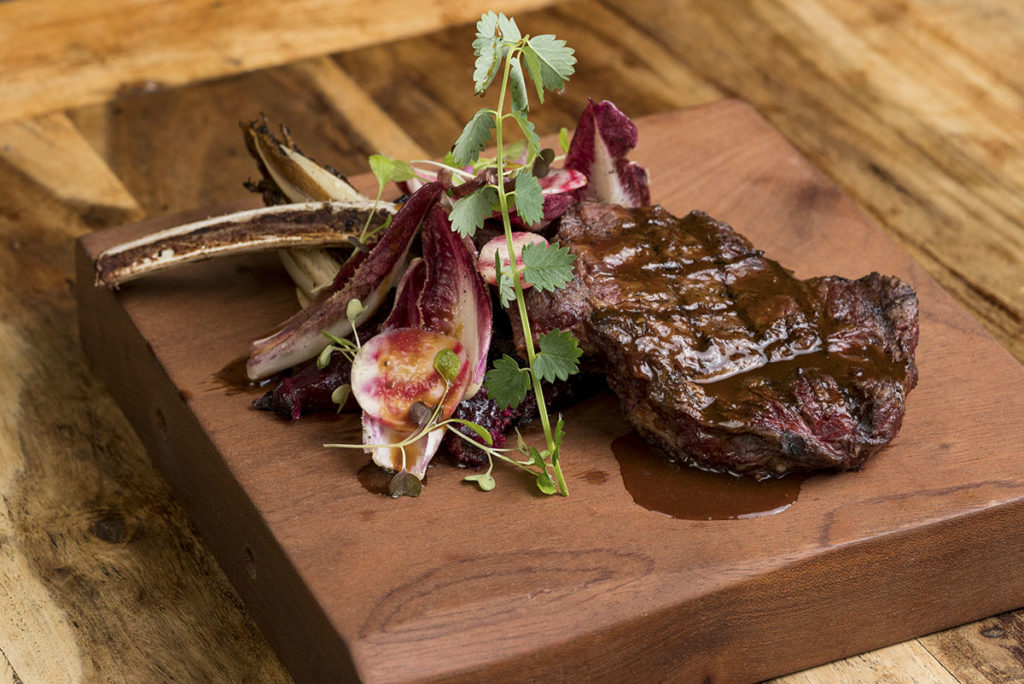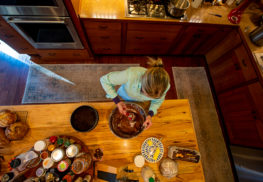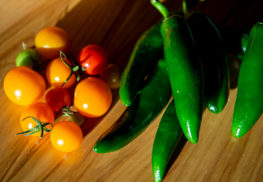Coffee-Rubbed Elk Loin

Recipe by Chef Mark Schmidt, Rainbow Lodge Restaurant
Featured Chef from the August/September 18 issue.
INGREDIENTS
(Serves 4)
- 4 North American elk chops
- ¼ cup olive oil
- ¼ cup espresso, finely ground
- 5 red Belgian endive
- 1 cup Roasted Beets (recipe following)
- 1 tablespoon freshly grated horseradish
- 2 teaspoons butter
- Juice of 1 half lemon
- Salt and pepper, to taste
- ½ cup Reduced Veal Stock (recipe following)
TO PREPARE:
-
- Heat gas or charcoal grill as you would for grilling steaks. While grill is heating, take one endive and separate the leaves. Slice the other endive in half, lengthwise. Rub the elk chops with 2 tablespoons of olive oil and season with ground espresso, salt, and pepper and set aside. Heat a sauté pan over medium heat, add the butter, beets, and horseradish, cook until hot, then set aside and keep warm.
- When grill is ready, add the endive halves cut side down around the edges of the grill and cook for 3 minutes, turn 45 degrees and cook for 3 more minutes, then turn over and grill again for 3 more minutes. Remove and reserve. At the same time as you are grilling the endive, cook the seasoned elk chops on the center of the grill. For medium rare, cook 5 to 6 minutes per side.
FOR THE ROASTED BEETS
- 2 medium beets (about 1 pound)
- 1 tablespoon olive oil
- Salt and freshly ground black pepper
TO PREPARE ROASTED BEETS:
-
- Heat the oven to 375 degrees and arrange a rack in the middle. Rinse the beets and trim off any leafy tops. Drizzle with olive oil, and season with salt and freshly ground black pepper.
- Wrap beets in aluminum foil and place in the oven. Roast until tender and easily pierced with a knife, about 1 to 1½ hours. Remove from the oven and let cool.
- When the beets are cool enough to handle, peel using a paring knife or by pushing the skin off with your fingers. Cut beets into wedges.
FOR THE REDUCED VEAL STOCK
- 10 pounds veal bones
- 3 carrots, roughly chopped
- 2 onions, roughly chopped
- 1 leek, white part only, roughly chopped (optional)
- 1 bouquet garni
- One 6-ounce can tomato paste
TO PREPARE REDUCED VEAL STOCK:
-
- Heat oven to 500 degrees. Put bones into a roasting pan large enough to hold them in a single layer and roast until lightly browned, about 1 to 1½ hours. Add carrots, onions, and leeks to the pan and spread them evenly around the bones. Roast the bones and vegetables until they are deeply browned, about 45 minutes more.
- To deglaze the pan, transfer bones and vegetables to a 15- to 20-quart stockpot. Pour off and discard any fat in the roasting pan and place pan over two burners on the stove, over medium heat. Add 3 cups water to pan and begin scraping up any browned bits from bottom of pan with a wooden spoon. These caramelized morsels of concentrated juice, called the fond, or the foundation, will enrich the stock. Simmer for 3 minutes; transfer liquid to pot of bones. Add bouquet garni and tomato paste. The paste will give the stock a deeper flavor and color. Cover bones with 6 to 8 quarts of cold water; set pot over medium-high heat. Starting with cold water encourages the proteins and fats contained in bones to rise to the surface in large pieces, where they can be skimmed and discarded.
- When the first bubbles begin to appear on the surface of the liquid, reduce heat to medium-low and maintain a very gentle simmer; a bubble should rise to the surface about once per second. Simmering slowly prevents the fat and impurities from being churned back into the stock and clouding it. The strength and concentration of your demi-glace will be determined by the length of time the stock simmers. For the minimum amount of extraction, it should simmer for at least 6 to 8 hours, but we recommend 12 to 24 hours for a richer, more gelatinous sauce. Check every few hours, adding more cold water if necessary so the bones are always covered.
- Skim any fatty froth from the surface of the stock with a ladle every 5 to 10 minutes during the first hour of cooking, to prevent it from clouding the stock. After the first hour, skim the stock every 30 minutes or so.
- When the stock is ready, set a chinois (a fine-mesh conical sieve) or a fine metal sieve over a clean 8-quart pot. Strain stock through the sieve into the pot. Tap edge of sieve with a wooden spoon to loosen any solids that impede the straining of the stock, but do not force liquid through. Discard bones, vegetables, and bouquet garni. The bones may be reused to make a lighter, secondary stock with fresh vegetables and aromatics, called remouillage, and used for sauces and soups. The stock should yield 4 to 5 quarts. If storing stock for another use, you can cool it quickly by placing the pot in a sink half filled with ice water. Once it’s cooled, skim the surface again to remove any fat. Transfer the stock you don’t plan to use right away to storage containers, and refrigerate. Stock will keep refrigerated for up to 1 week or frozen for up to 6 months. To transform the stock into demi-glace, proceed to next step.
- Traditionally, the stock for demi-glace was thickened with a roux, but modern chefs have shunned thickeners in favor of reducing stock to a purer, more syrupy consistency. To do this, simmer stock over medium-high heat, skimming occasionally, for 4 to 5 hours until reduced to about 2 cups. Refrigerate for up to 2 weeks or freeze for up to 6 months.
To Serve: Place cooked endive in the center of a serving platter, spoon horseradish and beets around the endive, and arrange the elk chops on top. Toss the separated endive leaves in the remaining olive oil, salt, pepper, and the lemon juice, and scatter over the top of the elk chops. Drizzle with reduced veal stock.
SHARE ON
You may also like
Recipe and commentary by Rachel Hogan...
Recipe and commentary by Joanne Linehan...
Recipe and commentary by Joanne Linehan...




























